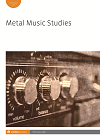
Full text loading...
Findings on metal research show an action-oriented, socially competent and less stressed community, opposing the assumption that metal reduces well-being and induces depression. Our study aimed to investigate the stress-reducing effects of metal for its fans and if this is influencing power experience. The idea is based on findings that indicate positive psychological and physical effects of music in general as well as the stress-reducing effects found for open, expansive gestures (e.g. ‘Metal gestures’). After stress was raised, participants listened either to metal or to classical music. While music was played, movements of half of the participants were blocked, thus, metal gestures were not possible. Metal music led to stress reduction of such blocked movements while classical music was found only to reduce stress when movements were not blocked. Stress reduction predicted the experience of power, but metal music and movements did not.

Article metrics loading...

Full text loading...
References


Data & Media loading...

Publication Date:
https://doi.org/10.1386/mms.5.2.137_1 Published content will be available immediately after check-out or when it is released in case of a pre-order. Please make sure to be logged in to see all available purchase options.